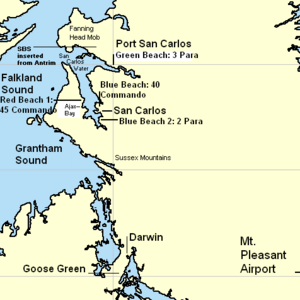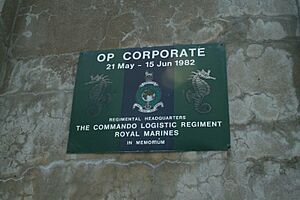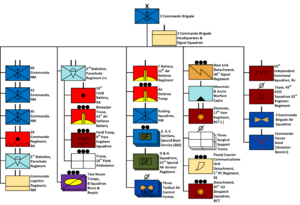British ground forces in the Falklands War facts for kids
The Falklands War was a short but important conflict in 1982 between the United Kingdom and Argentina. It happened because Argentina tried to take control of the Falkland Islands, which are a British territory in the South Atlantic Ocean. This article tells you about the British ground forces, which are the soldiers and marines who fought on land during this war. They were a big part of the effort to take back the islands.
Contents
British Land Forces
The United Kingdom sent a large group of soldiers and marines to the Falklands. This group was called the Land Forces Falkland Islands. It was made up of two main parts, called brigades:
- 3 Commando Brigade: This brigade was mostly made up of Royal Marines. The Royal Marines are special soldiers who are trained for fighting on land and from the sea. This brigade was usually ready to quickly respond to emergencies, especially in cold places like Norway. They were very good at landing from ships onto beaches. For the Falklands War, two battalions (smaller groups of soldiers) from the Parachute Regiment joined them.
- 5 Infantry Brigade: This brigade was usually ready for missions outside of Europe. For the Falklands War, two battalions of Foot Guards (famous British soldiers who often guard royal palaces) and a Gurkha battalion joined this brigade. Gurkhas are brave soldiers from Nepal who serve in the British Army. These units were chosen because they were available right away. This brigade also had special air defence units to protect the troops as they landed.
Land Forces Headquarters
The overall leader of the Land Forces in the Falklands was Major-General JJ Moore of the Royal Marines. He was in charge of planning and directing all the land operations.
3 Commando Brigade Units
The Commander of 3 Commando Brigade was Brigadier JHA Thompson. This brigade included many different types of units:
- Artillery Units: These units had powerful 105 mm Light Guns to provide fire support. They also had a special battery (148th) that helped direct naval gunfire from ships.
- Royal Marine Commandos:
- 40 Commando, Royal Marines: They were involved in fighting near Sapper Hill.
- 42 Commando, Royal Marines: They fought in battles like Mount Kent and Mount Harriet.
- 45 Commando, Royal Marines: They took part in battles including Two Sisters.
- Parachute Regiment:
- 2nd Battalion, Parachute Regiment: They were involved in the famous Goose Green and Darwin battles, and later Wireless Ridge.
- 3rd Battalion, Parachute Regiment: They fought battles like Mount Longdon.
- Support Units:
- Commando Logistic Regiment, Royal Marines: This unit made sure the fighting troops had everything they needed, like fuel and supplies.
- Engineers: Units like 9 Parachute Squadron Royal Engineers helped build things, clear obstacles, and deal with bombs.
- Aviation Squadron: This unit used Gazelle and Scout helicopters for transport and reconnaissance.
- Armored Vehicles: B Squadron, Blues and Royals had light tanks like the FV101 Scorpion and FV107 Scimitar.
- Air Defence: Units with Rapier missiles and Blowpipe missiles protected the troops from enemy aircraft.
- Special Forces: The SBS and 22 SAS are highly trained special forces units that carried out secret missions.
5 Infantry Brigade Units
The Commander of 5 Infantry Brigade was Brigadier MJA Wilson. This brigade also had many important units:
- Foot Guards:
- 2nd Battalion, Scots Guards: They fought in the tough battle for Mount Tumbledown.
- 1st Battalion, Welsh Guards: They were involved in operations near Sapper Hill.
- Gurkha Rifles:
- 1st Battalion, 7th Duke of Edinburgh's Own Gurkha Rifles: They secured Mount William.
- Artillery and Engineers: These units provided fire support and engineering help, similar to those in 3 Commando Brigade.
- Army Air Corps: 656 Squadron Army Air Corps used Gazelle and Scout helicopters for observation and moving small groups of soldiers.
- RAF Regiment: 63 Squadron RAF Regiment provided more air defence with Rapier missiles.
Infantry Weapons
British soldiers used a variety of weapons during the Falklands War:
- Main Rifle: The L1A1 SLR was the standard rifle for most soldiers.
- Machine Guns: The L4A3 Bren and L7A2 GPMG were used for heavier firepower.
- Grenades and Mortars: Soldiers used L2-A2 hand grenades, M79 grenade launchers, and different sizes of mortars (51 mm and 81 mm) to attack enemy positions.
- Anti-Tank Weapons: The L14A1 Carl Gustav Recoilless Rifle and MILAN missiles were used to destroy enemy bunkers and vehicles.
- Anti-Aircraft Weapons: The Blowpipe and Stinger missiles were used to shoot down enemy aircraft.
- Special Forces Weapons: Special forces units like the SAS used different weapons, including the M16A1 and CAR-15.
See also






